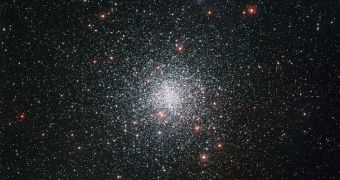A new astronomical image centered on a nearby cluster reveals a very young star amidst ranks of ancient ones. The object appears to have learned how to stay young forever, even if its companions formed at a time when the Universe was only a fraction of its current age.
Tens of thousands of stars lie in the tightly packed globular cluster known as Messier 4. While the vast majority of them show their years, one in particular captured the attention of astronomers at the European Southern Observatory.
Using the Wide Field Imager (WFI) instrument on the ESO/MPG 2.2-meter telescope, in Chile, the team was able to zoom in on the cluster, and analyze it in detail. Spectrographic analysis of the light emanating from the cluster revealed the stars' chemical composition.
From what astronomers know about stars, these objects contain certain amounts of both light and heavy chemical elements when they form. Over time, the initial quantities diminish, which is a measure of how old the stars get.
What ESO astronomers found was that one star in Messier 4 somehow managed to hold on to its reserves of a light element called lithium. Usually, very old stars reveal no signs of this chemical.
“The source of this lithium is mysterious. Normally this element is gradually destroyed over the billions of years of a star's life, but this one star amongst thousands seems to have the secret of eternal youth,” the team says.
“It has either somehow managed to retain its original lithium, or it has found a way to enrich itself with freshly made lithium,” they go on to say, adding that high amounts of sodium were also discovered around the star. The object has been designated #337934.
“The high lithium abundance of star # 37934 may originate by pollution from a previous generations of stars,” the group adds, in a study published on the University of Strasbourg's website.
Another potential explanation could be that the star itself had planetary companions at one point, which were eventually destroyed. The lithium they once contained returned into the star, contributing to its youthful appearance.

 14 DAY TRIAL //
14 DAY TRIAL //